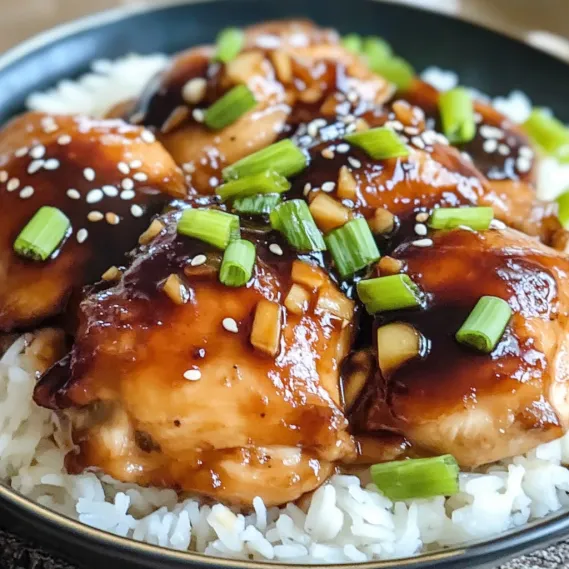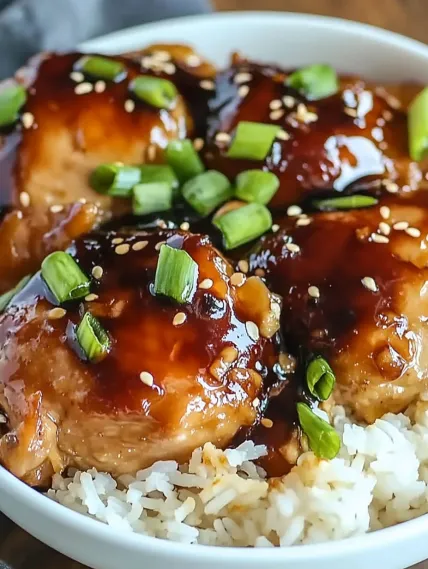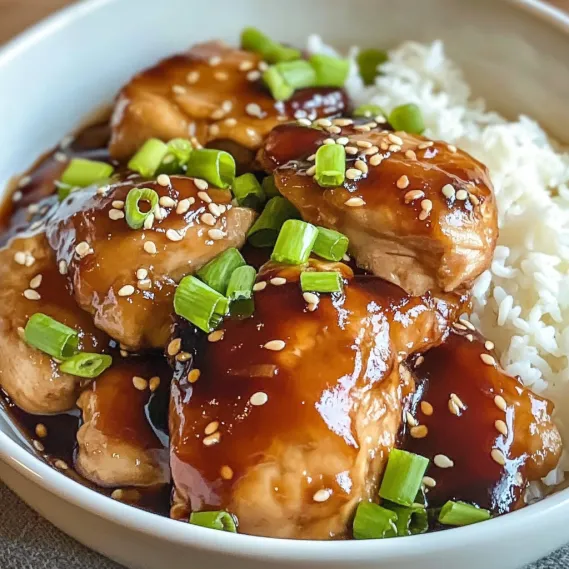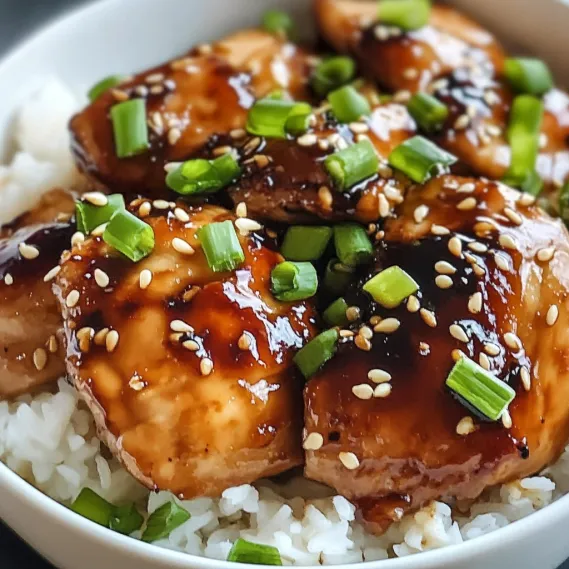 Pin
Pin
Hawaiian Teriyaki Chicken brings the sweet and savory flavors of the islands right to your table. Tender chicken marinated in a blend of soy sauce, pineapple juice, brown sugar, garlic, and ginger creates a bold, tropical profile that caramelizes beautifully when cooked. This versatile dish works perfectly for summer gatherings, family dinners, or meal prep.
I discovered this recipe when planning a backyard luau-themed dinner party. The dish was such a hit that three guests asked for the recipe before leaving. Now it's become our family's most-requested meal during summer grilling season and a reminder of our Hawaiian vacation.
Essential Ingredients and Selection Tips
- Chicken Thighs: Boneless, skinless thighs stay juicier than breasts. Look for uniform sizes for even cooking.
- Pineapple Juice: Use 100% juice without added sugars for authentic flavor. Fresh is best, but canned works well too.
- Soy Sauce: Low-sodium allows you to control saltiness. For gluten-free, substitute tamari.
- Brown Sugar: Creates the signature caramelization. Dark brown provides deeper molasses notes than light brown.
- Fresh Ginger: Provides zingy warmth that dried cannot replicate. Store peeled ginger in the freezer for easy grating.
I've found that marinating the chicken overnight rather than just four hours makes a remarkable difference in flavor penetration and tenderness. The extra time allows the pineapple enzymes to work their magic on the meat, creating an almost melt-in-your-mouth texture.
Detailed Cooking Instructions
- Step 1: Prepare the Chicken
- Use a meat tenderizer to pound both sides of the chicken thighs to an even thickness, which helps them cook uniformly and absorb more marinade. Place the tenderized chicken in a gallon-sized zip-top bag or non-reactive container, ensuring there's enough room for the marinade to fully surround the meat. Add 1½ cups soy sauce, 1½ cups packed brown sugar, 1½ cups pineapple juice, 2 tablespoons sesame oil, 8 cloves chopped garlic, and 2 tablespoons minced fresh ginger until the sugar completely dissolves. Pour this flavorful mixture over the chicken, seal the bag while pressing out excess air, and massage gently to ensure even coating.
- Step 2: Marinate Thoroughly
- Place the chicken in the refrigerator for at least 4 hours, though overnight (8-12 hours) provides significantly better flavor development. Turn the bag occasionally if possible to ensure even distribution of the marinade throughout all pieces of chicken, allowing the sweet and savory flavors to fully penetrate the meat.
- Step 3: Prepare for Cooking
- When ready to cook, remove the chicken from the refrigerator and let it sit at room temperature for 15-20 minutes while preheating your grill to medium heat (about 350°F). Transfer the marinade to a small saucepan, bring it to a boil, then reduce to a simmer for 5-10 minutes until it thickens into a glossy sauce.
- Step 4: Cook to Perfection
- Place the chicken on the preheated grill and cook for approximately 6-7 minutes per side, basting occasionally with the reduced marinade, until the internal temperature reaches 165°F and the exterior has a beautiful caramelized glaze. Transfer to a serving platter, drizzle with additional sauce, sprinkle with chopped green onions, and serve alongside sticky white rice.
- Step 5: Final Seasoning
- Let the chicken rest for 10 minutes after cooking to allow the flavors to meld together. Sprinkle with fresh chopped parsley before serving for a burst of color and fresh flavor.

I learned the importance of properly marinating the chicken after my first attempt resulted in a slightly dry texture. Those extra minutes make all the difference in the final creaminess of the dish.
The Origins of Hawaiian Teriyaki
This dish reflects Hawaii's multicultural heritage, combining Japanese teriyaki technique with local island ingredients. 'Teri' refers to the sauce's shine while 'yaki' means grilled. Japanese immigrants brought teriyaki to Hawaii, where pineapple juice was added to create a uniquely Hawaiian version that celebrates the islands' fusion cuisine.

Perfect Pairings and Sides
Complement this chicken with simple white sticky rice that absorbs the flavorful sauce. Add color with grilled pineapple rings, roasted vegetables, or a fresh cucumber-mango salad. For an authentic Hawaiian plate lunch, serve with macaroni salad and steamed vegetables. Coconut rice makes an excellent tropical alternative. For a healthier version, reduce sugar and serve with cauliflower rice.
Make-Ahead and Storage Tips
Prepare the marinade up to three days before using and store refrigerated. Marinated chicken keeps safely for 24 hours before cooking. Leftover cooked chicken stays delicious for three days refrigerated. Freeze uncooked marinated chicken for up to one month, or cooked chicken for two months.
Versatile Variations
Adapt this recipe to fit your needs. Use the same marinade with salmon, shrimp, or firm tofu. Add red pepper flakes for heat or orange juice for citrus notes. For a healthier version, reduce sugar and serve with cauliflower rice. Create kebabs by alternating chicken with pineapple chunks, bell peppers, and onions.
Troubleshooting Common Issues
For indoor cooking, use a grill pan or broil on high heat. If the chicken browns too quickly, move to indirect heat to finish cooking. For less saltiness, reduce soy sauce and increase pineapple juice. Dry chicken indicates overcooking – use a meat thermometer for perfect results.
Chef's Helpful Tips
- Reserve some unused marinade before adding chicken for a perfectly safe basting sauce
- Thread chicken onto skewers with pineapple chunks for easy Hawaiian kebabs
- For a charred exterior, grill on high heat initially then move to medium to finish cooking
- Add a tablespoon of cornstarch to the sauce when reducing for an extra-thick glaze
- Garnish with toasted sesame seeds for added texture and visual appeal
I've been refining this recipe for years, and the most significant improvement came when I started reducing the marinade into a thick sauce rather than discarding it. The concentrated flavors in that glaze transform good chicken into something truly special that transports us to the beaches of Hawaii with every bite.

This Hawaiian Teriyaki Chicken recipe proves that sometimes the most memorable meals come from honoring simple ingredients with straightforward techniques that allow their natural qualities to shine through.
Recipe FAQs
- → Can I use chicken breast instead of thighs for this recipe?
- Yes, you can substitute chicken breasts for thighs, though thighs tend to stay juicier and more flavorful. If using breasts, be careful not to overcook them as they can dry out more easily. You might want to reduce the grilling time to about 6-7 minutes per side, or until they reach an internal temperature of 165°F.
- → Can I make this in a slow cooker instead of grilling?
- Absolutely! To adapt this for a slow cooker, place the marinated chicken in the crockpot and cook on low for 4-5 hours or high for 2-3 hours. For the best flavor, remove the chicken once cooked, transfer the liquid to a saucepan, reduce it until thickened, then pour it back over the chicken.
- → Is there a way to make this recipe gluten-free?
- Yes, simply substitute regular soy sauce with gluten-free tamari or coconut aminos. Also ensure your pineapple juice doesn't contain any gluten additives (most pure juices are naturally gluten-free). Serve with gluten-free rice and you'll have a delicious gluten-free meal.
- → How long can I store leftovers?
- Leftover Hawaiian Teriyaki Chicken can be stored in an airtight container in the refrigerator for up to 3-4 days. It reheats well in the microwave or in a covered skillet over medium-low heat. You can also freeze it for up to 3 months - just thaw overnight in the refrigerator before reheating.
- → What sides go well with Hawaiian Teriyaki Chicken?
- While sticky rice is traditional, this chicken pairs beautifully with many sides. Try grilled pineapple slices, Hawaiian macaroni salad, stir-fried vegetables, or a simple green salad with mandarin oranges. For a complete Hawaiian-inspired meal, add some traditional poi or sweet potato if you can find them.
